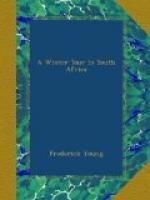On my return to Port Elizabeth, I spent another day or two there, and left on the evening of Monday, the 26th of August, by railway for Cape Town. This long journey of between eight hundred and nine hundred miles occupies nearly two days and two nights. It was the last I took in South Africa. The country, generally speaking, is very much of the same kind as that northward, over the Karoo, and in the southern part of the Transvaal. High land,—in the neighbourhood of Nieupoort 5,050 feet above the sea level,—flat, bare, and treeless. It is certainly a very desolate-looking country to travel over in winter. Nearing Cape Town, however, I ought not to omit to mention the Hex River Pass. The scenery here is certainly very grand, and is some of the best of its kind I have seen in South Africa. The railway, which winds through it by a succession of zigzags from a great height, is another of the many triumphs of engineering skill which are to be found in all parts of the world. The fine views of the Pass, when I traversed it, were heightened by the tops of the mountains being tinged with a wreath of snow. From Hex River the route to Cape Town lay through a rich and fertile valley, conveying ample proofs of the agricultural value and resources of this part of the Cape Colony. I arrived at Cape Town in the afternoon of the following Wednesday. Here I spent another pleasant week, seeing various friends.
[Illustration: HEX RIVER PASS.]
One of the last duties which devolved upon me before leaving South Africa—at the urgent invitation of some of my friends—was to deliver an address at Cape Town on Imperial Federation. This I did at the hall of the Young Men’s Christian Society, to a large and attentive audience.[C]
On the 4th of September I left Cape Town in the s.s. Athenian; and, after a pleasant and rapid voyage of eighteen days, touching only at Madeira on the way, I landed safely at Southampton on Sunday the 22nd.
I have now given an account of the prominent features of my tour, during which, in the course of five months, I travelled about twelve thousand miles by sea, and four thousand by land.
I proceed to touch as briefly as I can, on a few of the public questions, and other matters of interest which have arrested my attention while I was in South Africa.
[Footnote C: See Appendix.]
[Illustration: Decorative]
CLIMATE.
The climate of South Africa has already been so well, and exhaustively described, in the admirable and interesting paper, read at a meeting of the Royal Colonial Institute, on the 13th November, 1888, by Dr. Symes Thompson, that it seems superfluous for anyone to attempt to add anything to what such an eminent professional authority has said on the subject. But I cannot help remarking that, from my own personal experience, I can fully corroborate all he has said in its favour. The winter climate seems perfect. The atmosphere




